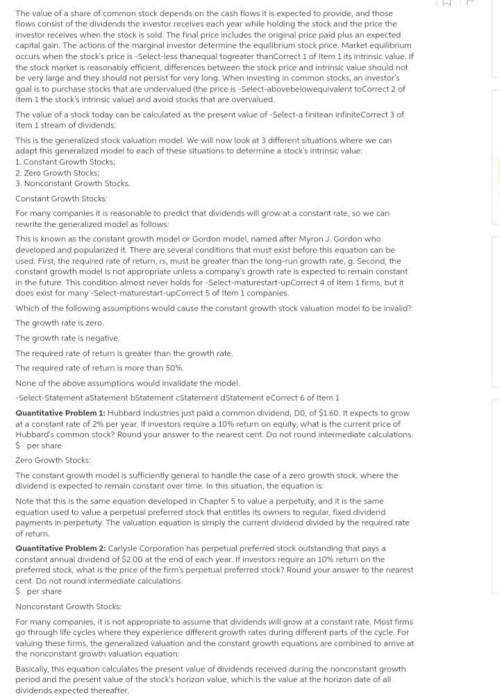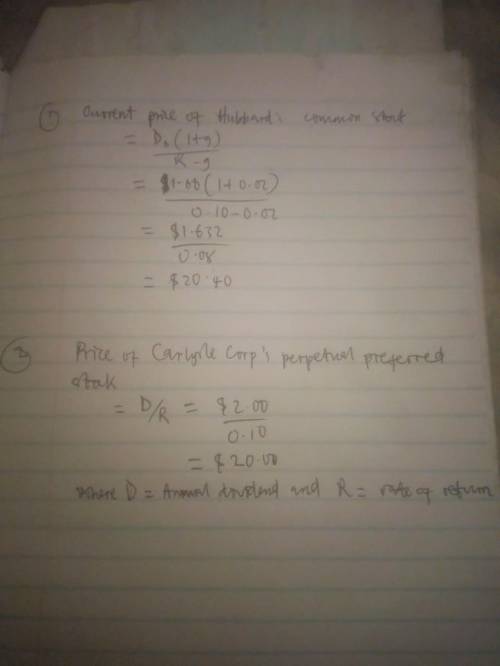
The value of a share of common stock depends on the cash flows it is expected to provide, and those flows consist of the dividends the investor receives each year while holding the stock and the price the investor receives when the stock is sold. The final price includes the original price paid plus an expected capital gain. The actions of the marginal investor determine the equilibrium stock price. Market equilibrium occurs when the stock's price is -Select-less thanequal togreater thanCorrect 1 of Item 1 its intrinsic value. If the stock market is reasonably efficient, differences between the stock price and intrinsic value should not be very large and they should not persist for very long. When investing in common stocks, an investor's goal is to purchase stocks that are undervalued (the price is -Select-abovebelowequivalent toCorrect 2 of Item 1 the stock's intrinsic value) and avoid stocks that are overvalued.
The value of a stock today can be calculated as the present value of -Select-a finitean infiniteCorrect 3 of Item 1 stream of dividends:
This is the generalized stock valuation model. We will now look at 3 different situations where we can adapt this generalized model to each of these situations to determine a stock's intrinsic value:
1. Constant Growth Stocks;
2. Zero Growth Stocks;
3. Nonconstant Growth Stocks.
Constant Growth Stocks:
For many companies it is reasonable to predict that dividends will grow at a constant rate, so we can rewrite the generalized model as follows:
This is known as the constant growth model or Gordon model, named after Myron J. Gordon who developed and popularized it. There are several conditions that must exist before this equation can be used. First, the required rate of return, rs, must be greater than the long-run growth rate, g. Second, the constant growth model is not appropriate unless a company's growth rate is expected to remain constant in the future. This condition almost never holds for -Select-maturestart-upCorrect 4 of Item 1 firms, but it does exist for many -Select-maturestart-upCorrect 5 of Item 1 companies.
Which of the following assumptions would cause the constant growth stock valuation model to be invalid?
The growth rate is zero.
The growth rate is negative.
The required rate of return is greater than the growth rate.
The required rate of return is more than 50%.
None of the above assumptions would invalidate the model.
-Select-Statement aStatement bStatement cStatement dStatement eCorrect 6 of Item 1
Quantitative Problem 1: Hubbard Industries just paid a common dividend, D0, of $1.60. It expects to grow at a constant rate of 2% per year. If investors require a 10% return on equity, what is the current price of Hubbard's common stock? Round your answer to the nearest cent. Do not round intermediate calculations.
$ per share
Zero Growth Stocks:
The constant growth model is sufficiently general to handle the case of a zero growth stock, where the dividend is expected to remain constant over time. In this situation, the equation is:
Note that this is the same equation developed in Chapter 5 to value a perpetuity, and it is the same equation used to value a perpetual preferred stock that entitles its owners to regular, fixed dividend payments in perpetuity. The valuation equation is simply the current dividend divided by the required rate of return.
Quantitative Problem 2: Carlysle Corporation has perpetual preferred stock outstanding that pays a constant annual dividend of $2.00 at the end of each year. If investors require an 10% return on the preferred stock, what is the price of the firm's perpetual preferred stock? Round your answer to the nearest cent. Do not round intermediate calculations.
$ per share
Nonconstant Growth Stocks:
For many companies, it is not appropriate to assume that dividends will grow at a constant rate. Most firms go through life cycles where they experience different growth rates during different parts of the cycle. For valuing these firms, the generalized valuation and the constant growth equations are combined to arrive at the nonconstant growth valuation equation:
Basically, this equation calculates the present value of dividends received during the nonconstant growth period and the present value of the stock's horizon value, which is the value at the horizon date of all dividends expected thereafter.
Quantitative Problem 3: Assume today is December 31, 2013. Imagine Works Inc. just paid a dividend of $1.15 per share at the end of 2013. The dividend is expected to grow at 15% per year for 3 years, after which time it is expected to grow at a constant rate of 6% annually. The company's cost of equity (rs) is 9.5%. Using the dividend growth model (allowing for nonconstant growth), what should be the price of the company's stock today (December 31, 2013)? Round your answer to the nearest cent. Do not round intermediate calculations.
$ per share

Answers: 2
Another question on Business

Business, 21.06.2019 20:20
On february 3, smart company sold merchandise in the amount of $5,800 to truman company, with credit terms of 2/10, n/30. the cost of the items sold is $4,000. smart uses the perpetual inventory system and the gross method. truman pays the invoice on february 8, and takes the appropriate discount. the journal entry that smart makes on february 8 is:
Answers: 3

Business, 22.06.2019 19:30
He moto hotel opened for business on may 1, 2017. here is its trial balance before adjustment on may 31. moto hotel trial balance may 31, 2017 debit credit cash $ 2,283 supplies 2,600 prepaid insurance 1,800 land 14,783 buildings 72,400 equipment 16,800 accounts payable $ 4,483 unearned rent revenue 3,300 mortgage payable 38,400 common stock 59,783 rent revenue 9,000 salaries and wages expense 3,000 utilities expense 800 advertising expense 500 $114,966 $114,966 other data: 1. insurance expires at the rate of $360 per month. 2. a count of supplies shows $1,050 of unused supplies on may 31. 3. (a) annual depreciation is $2,760 on the building. (b) annual depreciation is $2,160 on equipment. 4. the mortgage interest rate is 5%. (the mortgage was taken out on may 1.) 5. unearned rent of $2,580 has been earned. 6. salaries of $810 are accrued and unpaid at may 31
Answers: 2

Business, 22.06.2019 21:30
What term is used to describe the outsourcing of logistics? a. shipper managed inventoryb. hollow logistics(smi)c. sub-logisticsd. e-logisticse. third-party logistics (3pl)
Answers: 1

Business, 22.06.2019 21:50
Required: 1-a. the marketing manager argues that a $5,000 increase in the monthly advertising budget would increase monthly sales by $9,000. calculate the increase or decrease in net operating income. 1-b. should the advertising budget be increased ? yes no hintsreferencesebook & resources hint #1 check my work 8.value: 1.00 pointsrequired information 2-a. refer to the original data. management is considering using higher-quality components that would increase the variable expense by $2 per unit. the marketing manager believes that the higher-quality product would increase sales by 10% per month. calculate the change in total contribution margin. 2-b. should the higher-quality components be used? yes no
Answers: 1
You know the right answer?
The value of a share of common stock depends on the cash flows it is expected to provide, and those...
Questions

Spanish, 02.08.2019 17:30


Geography, 02.08.2019 17:30

Mathematics, 02.08.2019 17:30

Mathematics, 02.08.2019 17:30

Chemistry, 02.08.2019 17:30


Social Studies, 02.08.2019 17:30


Mathematics, 02.08.2019 17:30

Physics, 02.08.2019 17:30


Mathematics, 02.08.2019 17:30

Mathematics, 02.08.2019 17:30

Geography, 02.08.2019 17:30





Chemistry, 02.08.2019 17:30





